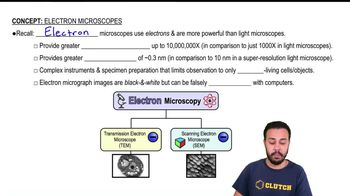Fill in the following blanks.
a. 1 μm = ______ m
b. 1= _______ 10⁻⁹ m
c. 1 μm = ______ nm
 Verified step by step guidance
Verified step by step guidance



Fill in the following blanks.
a. 1 μm = ______ m
b. 1= _______ 10⁻⁹ m
c. 1 μm = ______ nm
Assume you stain Bacillus by applying malachite green with heat and then counterstain with safranin. Through the microscope, the green structures are
a. cell walls.
b. capsules.
c. endospores.
d. flagella.
e. impossible to identify.
Which type of microscope would be best to use to observe each of the following?
a. a stained bacterial smear
b. unstained bacterial cells: the cells are small, and no detail is needed
c. unstained live tissue when it is desirable to see some intracellular detail
d. a sample that emits light when illuminated with ultraviolet light
e. intracellular detail of a cell that is 1μm long
f. unstained live cells in which intracellular structures are shown in color
Three-dimensional images of live cells can be produced with
a. darkfield microscopy.
b. fluorescence microscopy.
c. transmission electron microscopy.
d. confocal microscopy.
e. phase-contrast microscopy.
Carbolfuchsin can be used as a simple stain and a negative stain. As a simple stain, the pH is
a. 2.
b. higher than the negative stain.
c. lower than the negative stain.
d. the same as the negative stain.